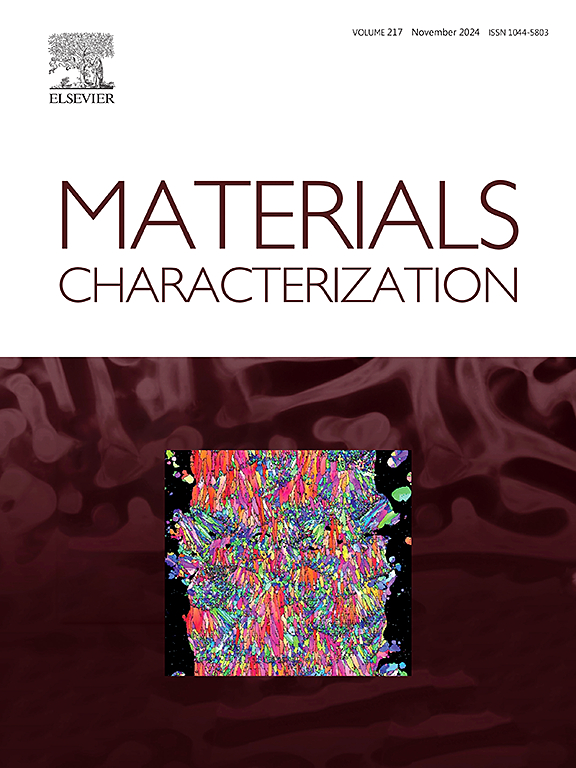单晶高温合金无涂层激光冲击强化的表面形貌、塑性变形和相变
IF 4.8
2区 材料科学
Q1 MATERIALS SCIENCE, CHARACTERIZATION & TESTING
引用次数: 0
摘要
无涂层激光冲击强化(LSPwC)作为一种表面处理方法,在保持单晶高温合金无晶界特性的同时,提高了合金的疲劳性能。然而,高温合金在不同的工艺参数下,喷丸表面的形貌和组织演变仍然是一个困惑。本研究探讨了LSPwC影响层的表面形貌、塑性变形、相变以及显微硬度增加的过程。激光脉冲使目标表面具有特定的形貌,初始粗糙度增大,多次热-机械循环后粗糙度逐渐减小。实验结果表明,在强化过程中,在表面下形成了由重铸层和变形层组成的层状结构。重铸层的平均深度为1 μm,由γ基体和富含Al和O元素的非晶态纳米颗粒组成,这些颗粒能够阻碍位错在后续强化过程中的滑动。此外,高温和应变梯度引起的扩散导致重铸层与变形层界面的元素偏析和γ′→γ相变。伴随着严重的塑性变形,晶体取向在变形层的滑移带上表现出明显的局部偏差。最后,由于γ′溶解、纳米颗粒的形成和位错的增殖,LSPwC处理后的试样表面硬度达到600 HV左右,深度硬度梯度达到350 μm左右。本文章由计算机程序翻译,如有差异,请以英文原文为准。
Surface morphology, plastic deformation and phase transformation in single crystal superalloys under laser shock peening without coating
Laser shock peening without coating (LSPwC) as a surface treatment has been demonstrated the ability to enhance the fatigue performance while maintaining the grain boundary-free nature of single crystal superalloys. The evolution of morphology and microstructure in the peened surface, however, still remains puzzled for the superalloys under varying technical parameters. This investigation explores the progression of surface topography, plastic deformation, phase transformation, as well as microhardness increment in the LSPwC affected layer. The laser pulses endue the target surface with a specific morphology and increase the roughness initially, while it diminishes gradually after multiple thermal-mechanical cycles. Experimental findings indicate that a stratified structure comprising a recast layer and a deformation layer is formed underneath the surface due to the thermal-mechanical effects during the peening process. The recast layer exhibiting an average depth of 1 μm, is composed of γ matrix and amorphous nano-particles rich in Al and O element, while these particles are capable of impeding dislocation glide in the subsequent peening. Additionally, the diffusion owing to high temperature and strain gradient causes elemental segregation and phase transformation of γ' → γ at the interface between the recast and the deformation layer. Accompanied by the severe plastic deformation, the crystalline orientation exhibits a noticeable local deviation across the slip bands in the deformed layer. Finally, as a result of γ' dissolution, nano-particles formation and dislocations multiplication, the LSPwC treated specimens exhibit a maximum hardness of approximately 600 HV at surface and a hardness gradient extending to around 350 μm at depth.
求助全文
通过发布文献求助,成功后即可免费获取论文全文。
去求助
来源期刊

Materials Characterization
工程技术-材料科学:表征与测试
CiteScore
7.60
自引率
8.50%
发文量
746
审稿时长
36 days
期刊介绍:
Materials Characterization features original articles and state-of-the-art reviews on theoretical and practical aspects of the structure and behaviour of materials.
The Journal focuses on all characterization techniques, including all forms of microscopy (light, electron, acoustic, etc.,) and analysis (especially microanalysis and surface analytical techniques). Developments in both this wide range of techniques and their application to the quantification of the microstructure of materials are essential facets of the Journal.
The Journal provides the Materials Scientist/Engineer with up-to-date information on many types of materials with an underlying theme of explaining the behavior of materials using novel approaches. Materials covered by the journal include:
Metals & Alloys
Ceramics
Nanomaterials
Biomedical materials
Optical materials
Composites
Natural Materials.
 求助内容:
求助内容: 应助结果提醒方式:
应助结果提醒方式:


